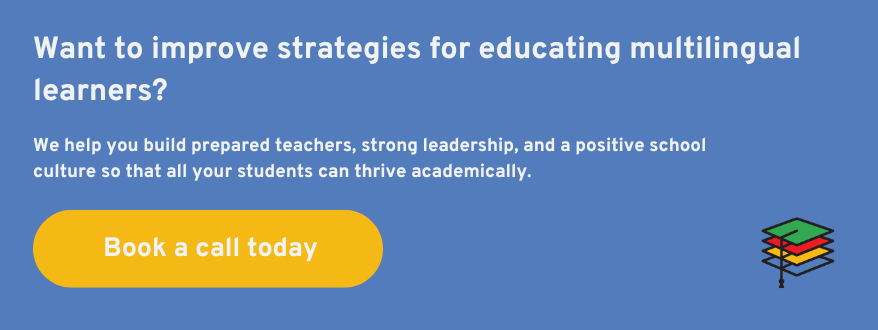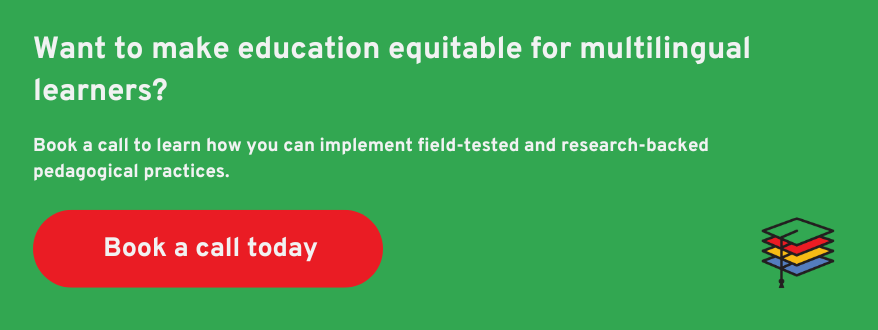One of the things we talk about a lot at Ensemble Learning is implicit bias.
In each of our professional development meetings, we extol the need to measure, recognize, and counter our own implicit biases.
We do this because English learners do not have equal access to high quality instruction, and this is often rooted in unconscious bias on the part of teachers and school leaders.
It’s important to set the expectation that not only is it necessary to examine these biases but it is also imperative to put systems in place to measure and combat them.
Contents
What is implicit bias and how to avoid it?
Implicit bias isn’t something that only racist or bad people have, but something that we all have as a product of our different experiences.
It isn’t a moral judgement to say someone has an implicit bias because we all have them.
Even at Ensemble, where we have a team of people who are committed to equity, we are not immune to holding implicit biases.
Thinking that you are the exception may mean that you have implicit biases that haven’t been identified or addressed.
How we examine our implicit bias
To illustrate this point, each of our team members want to share a time we identified (either by our own education or by having others point it out to us) and combatted our own implicit biases to highlight that even people with the best of intentions have to do the work to question and improve their cultural responsiveness.
Elise – One of my first teaching jobs was in an affluent, mostly white suburb.
There were few students of color and even fewer English learners until beautiful, effervescent Selena bounced into my kindergarten classroom. She spoke almost no English but participated in every activity with energy and interest.
When it came to the end of the year, I assumed she shouldn’t move on because her English wasn’t fluent. I didn’t consider her growth, her Spanish literacy or even her mastery of content.
She was an English learner so I assumed she shouldn’t move up. Luckily, I called a professional to consult before making the decision. I’m so thankful someone else corrected my implicit bias mistake!
James – During my first couple of years as a principal, my area superintendent received several complaints from parents about a look that I was giving them that made them feel uncomfortable and put down by me.
The job was challenging and new, so I expected there to be a learning curve and some hiccups in my path to becoming a passable school leader, however, I had a hard time accepting the validity of the complaints.
I had an open door policy for parents and welcomed their concerns, challenges, and all types of feedback that they offered on a regular basis. I had only a handful of complaints all year and had over 500 students’ families to answer to, so I thought that I was doing a fine job.
My area superintendent was not happy with any complaints, however, and wanted to go deeper into “the look” that was being referred to by the parents. My score of a 2/4 on my yearly evaluation got me to reflect on the issue and forced me to seek out the source of “the look” and a way to deal with it so that it would not cause me further problems. Upon reading the complaints and reflecting on my relationship with the parents who wrote the complaints, I discovered that all of the parents who had complained about my look were parents who were not very visible or invisible on campus.
They did not do volunteer hours, they did not come to school meetings, they did not drop off or pick up their kids at school.
My look, the outward expression of my implicit bias, was a judgement on their parenting. If they were not visibly involved with their kid at school, I felt they were not doing as good of a job as they could be doing raising their kid.
It was simple and though I was not saying it aloud, these parents felt my judgement in my look and that was no way to build the relationships needed to help their child succeed in school.
After that year, I never received another complaint for my look.
It took a bad evaluation and some serious self-reflection to help me realize that I need to check some of my beliefs about childrearing and what I was bringing to the table every time I met with parents who may or may not have been raising their kids according to those beliefs.
I know now that I need to acknowledge that I have these biases and also know that everyone is trying to do the best that they can with what they have. I can only try to meet them where they are with an open mind and go from there.
JC – I was in my early years as an administrator and the school year had just started.
A middle school teacher suddenly resigned only a few weeks into the school year. The leadership team and I quickly moved to review résumés and identify candidates to interview.
The school had a high percentage of English learners and we wanted to make sure our students had a teacher in front of them that understood them, supported them, and could teach them well. After our first round of interviewing candidates, we looked at each other and couldn’t understand why none of them met the criteria for our students.
The candidates could neither relate to our student population nor did they demonstrate the empathy needed to ensure our students were supported. As we debriefed the candidates, we realized it was our process for identifying candidates that needed to be addressed. We had unconsciously prioritized candidates with surname that resembled our student population – this was our implicit bias in action.
Clearly, we wanted to do right by our students, but a name cannot tell you about a person’s experiences or their connection to a community. As a result, for round two of candidate selection, we added a step to address our implicit bias: block out all names on the resumes. This allowed the leadership team to focus only on the experiences each candidate brought.
To further protect against bias in the interview, we created a standard set of 5 key questions to ask all candidates as well as a common rubric for their responses.
This helped ensure our biases did not hinder us from selecting the best teacher for our students. Through this, I learned that having a process for identifying, selecting, and matching teachers to students makes a world of a difference, and thankfully we did find a teacher that loved, related to, and taught our students well for many years.
Katherine – I began my teaching career in a school in the northeast San Fernando Valley of Los Angeles.
I wanted to work in a community that hadn’t always had equitable educational opportunities, and I immediately felt a pull towards this community, my fellow colleagues, and the students. What I didn’t acknowledge was the unconscious bias that I carried with me about students who looked the way my students did and who had the experiences my students had.
In addition, due to my own (privileged) upbringing, I had a fairly fixed perception of how students should behave and interact in the classroom, and a lack of empathy for the variety of appropriate ways of interacting that different cultures bring into a learning space. In the early fall of my first year of teaching, I had a tense situation with a student who would not put away some materials I asked her to store in order to refocus on the learning activity we were in the middle of.
My immediate thought was that she was being defiant, and I escalated the situation to involve a dean to support with her difficult behavior.
Luckily, I had amazing mentors who helped me understand myself and the implicit bias that acted behind the situation.
What I quickly perceived as defiance, a term often associated with students of color, was the student’s coping mechanism to stress, an underdeveloped relationship with me (a new teacher), and a new situation.
My beliefs about “appropriate” classroom behavior were completely dictated by my own culture and upbringing, and I hadn’t taken the time to understand more effective ways of interacting with and understanding my students who came into my classroom with a different culture and different experiences.
Something I learned, and I think is important for all educators to understand, is that implicit bias does not make you a bad person. In fact, every single person walking on this earth has implicit bias. What we do about implicit bias, how we examine our own biases, and how we consciously change our behaviors based on our own implicit biases is what dictates what kind of person we are.
Kettisha – I recall an incident that occurred when I was a teacher making copies in the lounge during my planning period. A consultant sat at the table waiting for teachers to stop by for treats and listen to information about whatever product she was selling.
A teacher walked over to her and they started speaking in Spanish.
I commented to another teacher near me, “I thought she was black” (in reference to the consultant). Once I finished making copies, I wandered over to browse the materials on the table.
As I was leaving, the consultant caught me at the door, smiled, and quietly said, “I heard you at the copy machine, and I am black. And, I speak Spanish.” I immediately apologized and admitted I made a foolish assumption.
In that moment I learned two lessons about my implicit bias about language. 1. African Americans can speak languages other than English and 2. Hispanic people are not the only people who can speak Spanish.
Not a proud moment, but I have never made another assumption about what language a person may or may not speak based on their race.
Leigh – When I was teaching pre-service teachers during graduate school, I taught a developmental psychology course for future elementary school teachers.
While prepping for the course, I took materials I had used for secondary teachers and “dumbed them down” because I thought that elementary school teachers were just silly girls who liked to babysit.
A few weeks into the semester, I actually had one of my students call me out on this in her anonymous reviews.
She told me that I was not pushing them or holding them to high expectations. At that point, I had to examine what I was doing and why I was doing that.
I wasn’t scaffolding because my students needed support, I was assuming they couldn’t handle the material and lowering the expectations. I was not providing the quality education these students deserved because I assumed they couldn’t do it before even getting to know them or their work.
It was an embarrassing and painful eye opener for me, but moving forward, I did step up the rigor of the course.
It was also an experience that challenged me to think about all the brilliant and amazing elementary school teachers I know and ensure that I don’t make this assumption again.
Rocío – During my first year of teaching AP Spanish Language and Culture at the high school level, I was nervous about preparing my students to do well on the exam.
The school that I was working had high expectations for student pass rates and would not only publish the passing rate for each teacher but would also tie the results to our yearly bonus. I was especially worried about non-native Spanish speakers passing the test.
That year I invited one of my colleagues to come and observe my teaching twice a month in order to help me sharpen my skills. My colleague approached me after the third observation and had a “courageous conversation” with me.
It turns out that I was calling on non-native Spanish speakers to participate in class substantially more than the native Spanish speaking students.
I was so concerned about ensuring that non-native Spanish speakers had enough practice that I was not providing equal access to native Spanish speakers.
My colleague not only spoke to me about it, but also provided me with data based on my classroom observations. They kept tally during the three observations and were able to show me the disproportionate participation rates. I was shocked! My implicit bias was affecting the way I was teaching.
I was grateful for a colleague who helped me see my flaw. I wasn’t my intention to lean towards one subgroup or another. In order to ensure a more equitable practice, I incorporated the use of equity sticks in my classes.
Even when they intentions are good our implicit biases can harm others.
Sherre – As a new teacher, I saw “education” and “hard work” as the levers for creating social change — and not without reason.
I am a first generation college graduate who started contributing financially to my household at the age of 16; I was deeply acculturated in the “protestant work ethic;” my own academic success was a byproduct of long hours and sacrifices; I came from a family where a job meant a roof and food, and was thus always prioritized over leisure and comfort; and let’s face it: teaching well is hard and time consuming.
This context made it pretty easy for me to blatantly dismiss educators who didn’t obviously put in long hours (on weekends and over breaks, too!).
In my mind, the worst of the worst were the ones who booked it off campus as soon as the parking gate was opened.
Didn’t they care about the children we had all agreed to serve? Didn’t they have professional integrity? Couldn’t they see that the work was bigger than their own agendas?
Over time, I learned that the demands of public education in this country are all consuming.
I have watched brilliant educator after brilliant educator leave this field because the demands are too high. Empathy fatigue is real. Educators who want to stay in the work for the long haul need clearly defined boundaries.
It is the only way to keep committed to such intense work. As I realized this, I noticed that I was working with no boundaries, and saw the toll it had taken on my health & my ability to have any sort of life beyond the classroom.
With this new knowledge, I realized that many of the “early escapers” were just trying to survive.
Then, I had a baby.
Wow. Wow. Wow, did that change my world.
I still love the thousands of “babies” I taught before her. I’ve still given up time with her to be in parent meetings.
But now I understand that deep, soul-call to get home to her. That desire to grasp and hold every second possible. Looking back, I saw that many of my colleagues who were rushing out the door were parents of small children.
My heart melted for them.
I have to admit, I still resist “early escapers” who are cavalier about stepping out and leaving their colleagues to pick up the slack, or whose work (when they are present) isn’t high quality; but I am far more open to the human reasons for all of us needing to step away.
Tanya – I spent several years on a team that launched 2 schools in predominantly black neighborhoods in New Orleans serving high-need students.
During the first few years of growth, nearly half of my time was spent supporting teachers in classrooms and working closely with the culture dean and running student recruitment. In the early days, I walked from room to room to check morning attendance.
As a result, I knew the 200+ children very well. Eventually, I could identify a child just by voice, shoes or even at a distance by the way s/he walked. This resulted in something shameful. From time to time, I’d have conversations with counterparts about our students’ names.
It always started off innocently, but we would make jokes about the ridiculous spellings and pronunciations. I remember being quite happy with myself because I could usually “one-up” any of my friends when playing the name game.
At the same time, I knew about all the data that proved hiring managers were less likely to even consider a qualified candidate with an “ethnic” name.
I knew it, and I hated it, but I also resented the parents who gave their children those names. At my school, I made assumptions about the mother (not the father, which is another issue) of the children with less common names that Mom was a) simple or b) trying to prove a point concerning the child’s paternity.
I adamantly believed the mother was handicapping her child who was already starting from a position of struggle in our society. It took years for me to see my own bias clearly. While I still cringe over names that seem “too unique” from time to time, I learned that a parent’s choice of names should never be tied to value. It is a parent’s right to choose a name that s/he believes is symbolic, melodic or a tribute to their family.
That this choice is an expression of pride and uniqueness is no longer invisible to me.

Want to learn more about implicit bias?
If you want to think more about your own implicit biases, it can be helpful to start with a test that measures them.
We like the Harvard Project Implicit tests (bonus: your data is used to anonymously power Harvard’s research!)
Book a call with us to get coaching on how to improve your pedagogy practices and make education equitable for multilingual learners.
If you or your staff are interested in Ensemble Learning’s tools to identify, measure, and combat implicit bias, reach out to Dr. Leigh Mingle at lmingle@ensemblelearning.org for more information.






